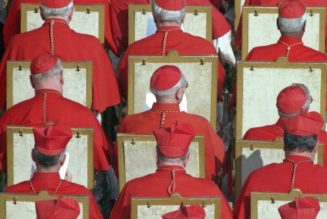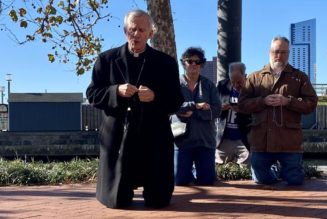In the 1970s, during the heyday of the chaos that followed Vatican II, a French bishop, when asked why he did not more firmly address the crisis, replied, “What can I say? I wasn’t chosen because they thought they might find a prophet in me, but just an administrator.” The Church has always struggled to find good leaders (especially bishops). However, as recently as a hundred years ago, bureaucratic structures did not dominate its life as they do today. What happened?
In 1941, James Burnham published The Managerial Revolution, which might help shed some light on the situation. Burnham was a former Marxist who claimed that Western nations were transitioning from a capitalist society to a “managerial” one in which power would pass from owners of capital to managers who controlled the instruments of production. Though he hardly mentions the Church, there is something to be learned by the comparison. Like every other institution in western life, the Church is run on a daily basis by those who control the means—of communication, funding, and the like—to accomplish the ends for which they are constituted, rather than those who are responsible for its end. In the Church’s case, this means the salvation of souls often takes a back seat to bureaucratic inertia.
Episcopal conferences are the focal points for much of this bureaucratization. The first national conference was founded in Switzerland in the 1860s, but the paradigm for those institutions has long been the U.S. Bishops’ Conference. Founded as the National Catholic War Council in 1917 to represent Catholic interests in Congress and coordinate with the federal government during WWI, its founders changed its name to the National Catholic Welfare Council, with the intent of continuing its activities. Yet some bishops and some in Rome worried this would erode the powers of individual bishops and of Rome itself. Such opposition nearly scuttled it altogether; in 1922, Benedict XV was ready to squelch the promulgation of the decree allowing its creation before he died. Pius XI signed it, though its name was changed to “conference” to indicate its merely consultive function.
It was perhaps inevitable that the U.S. conference would become the exemplar for ecclesial bureaucracy. Americans invented the legal device of the corporation, replacing family firms as the model for “big business.” Certainly, the original aims of the NCWC were not directly related to spiritual goods. It possessed five departments—Education, Press and Publicity, Social Action, Laws and Legislation, and Lay Organization—only Education, with its promotion of Catholic schools, aimed at anything like a “religious” end. (Today, its successor, the USCCB, is comprised of sixteen departments.)
Notable was the concern for publicity. Its Press Office issued a weekly newssheet to eighty-seven newspapers, unsurprising given that it was an American, Ivy Lee, who invented the “press release” in 1914. (In the 1930s, Cardinal Spellman of New York would hire Lee’s publicity firm, among others, to handle publicity for the Archdiocese.) Similarly, the publicity-conscious American bishops, in 1962, set up a press panel a week after the Second Vatican Council opened in response to journalists’ requests.
As with much else, Vatican II was the main accelerant for the Church’s managerial revolution. The Council advocated the creation of national bishops’ conferences but also diocesan commissions and parish councils. Dioceses-held synods were held in its aftermath, following Paul VI’s erection of the Roman Synod, a consultative body of bishops, just before the close of Vatican II in 1965. The hierarchs at Vatican II conducted their business along lines similar to a bishops’ conference, with committees producing documents to be voted on by the bishops as a whole, rather than bishops arguing over issues themselves, as they did at Trent. Unsurprisingly, council periti—academic experts—played a crucial role in the shaping of those documents. Vatican II saw the triumph of experts needed to deal with and communicate with the “modern world”—lawyers, publicists, psychiatrists, academics—which have come to dominate its life.
This revolution reached its apex in the creation of the new liturgy. Liturgists and theologians provided the rationale for and the means of implementing the new rite, since they were well versed in the administrative networking so crucial to middle class professionals. This new credentialed Catholic “knowledge class” served the numerous bodies responsible for creating and implementing the new rite: the Consilium for Implementing the Constitution on the Sacred Liturgy, the Congregation for Divine Worship, Episcopal Conferences, the commissions which translated the new missal into vernacular languages, diocesan and parish committees, all worked to ensure their liturgical ideas appeared to largely indifferent bishops as the natural outcome of Vatican II, and as a consequence they drove the creation of the new liturgy. Susan Benefoy has described this process for the U.S. in detail, but the picture could no doubt be replicated in other countries.
The Vatican also furthered this revolution, despite already having a centralized bureaucracy and despite the vaunted “collegiality” proclaimed at Vatican II. When Paul VI reorganized the papal Curia in 1967, effective control over other curial departments fell to the Secretariate of State, marking a “turn to the world” in its orientation, downgrading the importance of the Congregation for the Doctrine of the Faith (formerly the Holy Office). Paul VI also allowed bishops to be members of curial congregations (previously, only cardinals were allowed). Such reforms made the Vatican more centralized than ever. When the Roman Synod objected to the liturgy the Consilium concocted in 1967, the Consilium simply ignored it, and Paul VI promulgated that liturgy virtually unchanged in 1970, on his own authority. Meanwhile, the number of Vatican officials grew during Paul VI’s pontificate from 1,322 to 3,150 (the number is around 4,800 today).
Some sort of bureaucracy is necessary for the maintenance of the Church’s various endeavors, and there are still good people working in diocesan and Vatican bureaucracies. But personnel is policy, and the Church’s managerial elite mostly share the same training and predilections as their secular counterparts, and these often conflict with the faith of the Church. As the late Fr. Paul Mankowski once noted, priests come almost entirely from this class and know how to talk to other professionals but not to working class or even simply non-professional members of the Church, who comprise most of their flock.
Critics have noted that the dependence of the Church on government funding, especially in America and Germany, makes it unlikely that the Church will act in ways that upset secular governments. (Not coincidentally, Germany’s church tax also dates from the WWI era, like the USCCB.) The current administrative regime in the Church sees it as a primary task not to upset such relationships, formed in the postwar era, and this is one reason why the Church fails to act on its most contested beliefs (on sexuality, on its claim to be the true Church, etc.).
This also explains why it is so difficult, if not impossible, to get anyone in the Church to admit the failure of any part of Vatican II or the reformed liturgy. Both have their origins in the public mood of postwar Europe and America in the 1960s, and many working for the Church today owe their jobs to one or the other, or both.
Most liturgical bodies today would not exist except for the new rites, and any program or institution containing the words “pastoral” or “evangelization” is justified almost solely in terms of fulfilling some directive (real or imagined) of Vatican II. Any criticism of either must appear to Church administrators as a threat to their livelihoods and to the kind of public order from which they have personally benefited. Thus, they continue to protect failed post-conciliar reforms at all costs, “adapted to the circumstances” (Christus Dominus, 38) of an era (the 1960s) that has long since passed away, for both ideological and practical reasons.
Burnham doesn’t give any clue on how to take back control from this “managerial class,” and his later work Suicide of the West doesn’t inspire optimism. In that work, he describes “liberalism” as an ideology which allowed Western leaders, who had already lost belief in the uniqueness and goodness of Western civilization, to believe they were entering a wonderful new phase of history even as it collapsed around them. With the “Synod on Synodality” now upon us, his analysis is becoming more applicable to the Church by the day. And yet, there may be hope that, in part at least, the Church’s bureaucratic malaise is generational, as its current managerial class came of age in the 1960s and is now passing from the stage. In the Church’s earthly pilgrimage, a new generation of leaders has, on occasion, reversed a decline into worldliness, as with the twelfth-century Gregorian reformers. We should work for and pray that such a change occurs sooner rather than later, before the Western Church manages itself into oblivion.
[Photo Credit: Christine Rousselle/CNA]
Join Our Telegram Group : Salvation & Prosperity









